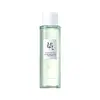What's inside
What's inside
 Key Ingredients
Key Ingredients

 Benefits
Benefits

 Concerns
Concerns

 Ingredients Side-by-side
Ingredients Side-by-side

Water
Skin ConditioningPrunus Mume Fruit Water
HumectantDipropylene Glycol
HumectantGlycerin
HumectantGlycolic Acid
BufferingButylene Glycol
HumectantTromethamine
Buffering1,2-Hexanediol
Skin ConditioningSalicylic Acid
MaskingHydroxyacetophenone
AntioxidantOctyldodeceth-16
EmulsifyingC12-14 Pareth-12
EmulsifyingEthylhexylglycerin
Skin ConditioningVigna Radiata Seed Extract
Skin ConditioningDisodium EDTA
Xanthan Gum
EmulsifyingMelia Azadirachta Leaf Extract
Skin ConditioningMelia Azadirachta Flower Extract
Skin ConditioningCoccinia Indica Fruit Extract
Skin ConditioningOcimum Sanctum Leaf Extract
Skin ConditioningCurcuma Longa Root Extract
MaskingAloe Barbadensis Flower Extract
EmollientSolanum Melongena Fruit Extract
Skin ConditioningCorallina Officinalis Extract
Skin ConditioningWater, Prunus Mume Fruit Water, Dipropylene Glycol, Glycerin, Glycolic Acid, Butylene Glycol, Tromethamine, 1,2-Hexanediol, Salicylic Acid, Hydroxyacetophenone, Octyldodeceth-16, C12-14 Pareth-12, Ethylhexylglycerin, Vigna Radiata Seed Extract, Disodium EDTA, Xanthan Gum, Melia Azadirachta Leaf Extract, Melia Azadirachta Flower Extract, Coccinia Indica Fruit Extract, Ocimum Sanctum Leaf Extract, Curcuma Longa Root Extract, Aloe Barbadensis Flower Extract, Solanum Melongena Fruit Extract, Corallina Officinalis Extract
Water
Skin ConditioningGlycerin
HumectantMyristic Acid
CleansingPotassium Hydroxide
BufferingGlyceryl Stearate Se
EmulsifyingStearic Acid
CleansingLauric Acid
CleansingPalmitic Acid
EmollientCoco-Glucoside
CleansingWithania Somnifera Root Extract
Skin ConditioningTerminalia Ferdinandiana Fruit Extract
AntioxidantUrea
BufferingTea-Lactate
HumectantAllantoin
Skin ConditioningSorbitol
HumectantFructose
HumectantSodium Chloride
MaskingSodium Lactate
BufferingSerine
MaskingHydroxyacetophenone
AntioxidantCaprylyl Glycol
EmollientCitric Acid
BufferingTrisodium Ethylenediamine Disuccinate
Lactic Acid
BufferingLactobacillus Ferment
Skin ConditioningMaltodextrin
AbsorbentPentylene Glycol
Skin ConditioningPotassium Sorbate
PreservativeSodium Benzoate
MaskingSalicylic Acid
MaskingParfum
MaskingLimonene
PerfumingWater, Glycerin, Myristic Acid, Potassium Hydroxide, Glyceryl Stearate Se, Stearic Acid, Lauric Acid, Palmitic Acid, Coco-Glucoside, Withania Somnifera Root Extract, Terminalia Ferdinandiana Fruit Extract, Urea, Tea-Lactate, Allantoin, Sorbitol, Fructose, Sodium Chloride, Sodium Lactate, Serine, Hydroxyacetophenone, Caprylyl Glycol, Citric Acid, Trisodium Ethylenediamine Disuccinate, Lactic Acid, Lactobacillus Ferment, Maltodextrin, Pentylene Glycol, Potassium Sorbate, Sodium Benzoate, Salicylic Acid, Parfum, Limonene
 Reviews
Reviews

Ingredients Explained
These ingredients are found in both products.
Ingredients higher up in an ingredient list are typically present in a larger amount.
Glycerin is already naturally found in your skin. It helps moisturize and protect your skin.
A study from 2016 found glycerin to be more effective as a humectant than AHAs and hyaluronic acid.
As a humectant, it helps the skin stay hydrated by pulling moisture to your skin. The low molecular weight of glycerin allows it to pull moisture into the deeper layers of your skin.
Hydrated skin improves your skin barrier; Your skin barrier helps protect against irritants and bacteria.
Glycerin has also been found to have antimicrobial and antiviral properties. Due to these properties, glycerin is often used in wound and burn treatments.
In cosmetics, glycerin is usually derived from plants such as soybean or palm. However, it can also be sourced from animals, such as tallow or animal fat.
This ingredient is organic, colorless, odorless, and non-toxic.
Glycerin is the name for this ingredient in American English. British English uses Glycerol/Glycerine.
Learn more about GlycerinHydroxyacetophenone is antioxidant with skin conditioning and soothing properties. It also boosts the efficiency of preservatives.
This ingredient is not irritating or sensitizing.
Salicylic Acid (also known as beta hydroxy acid or BHA) is a well-known ingredient for treating skin that struggles with acne and clogged pores. It exfoliates both the skin's surface and deep within the pores to help clear out buildup, control oil, and reduce inflammation.
Unlike AHAs (alpha hydroxy acids), salicylic acid is oil-soluble. This allows it to penetrate into pores which makes it especially effective for treating blackheads and preventing future breakouts.
Salicylic acid is also known for its soothing properties. It has a similar structure to aspirin and can calm inflamed or irritated skin, making it a good option for acne-prone skin that is also sensitive.
Concentrations of 0.5-2% are recognized by the U.S. FDA as an over-the-counter topical acne product.
It can cause irritation and/or dryness if one's skin already has a compromised moisture barrier, so it's best to focus on repairing that before introducing this ingredient into your routine.
While salicylic acid does not increase sun sensitivity, it’s still important to wear sunscreen daily to protect your skin.
If you are looking for the ingredient called BHA or Butylated Hydroxyanisole, click here.
Learn more about Salicylic AcidWater. It's the most common cosmetic ingredient of all. You'll usually see it at the top of ingredient lists, meaning that it makes up the largest part of the product.
So why is it so popular? Water most often acts as a solvent - this means that it helps dissolve other ingredients into the formulation.
You'll also recognize water as that liquid we all need to stay alive. If you see this, drink a glass of water. Stay hydrated!
Learn more about Water